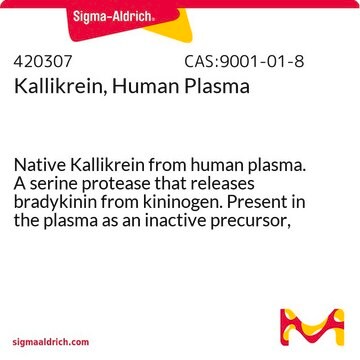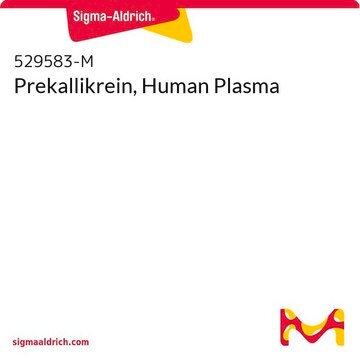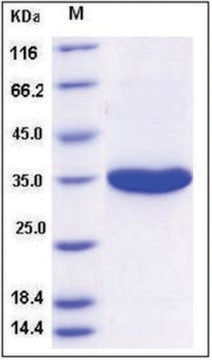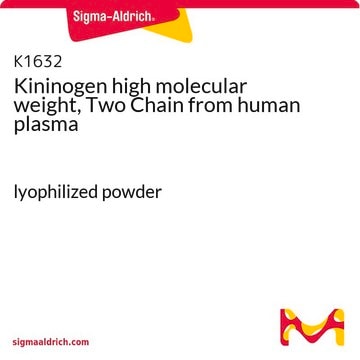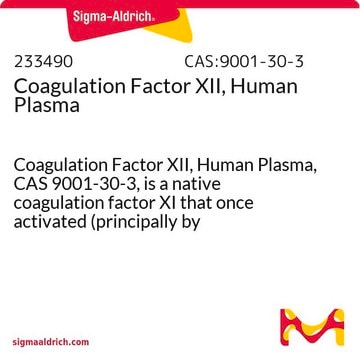推薦產品
形狀
buffered aqueous solution
品質等級
比活性
≥5 units/mg protein
UniProt登錄號
運輸包裝
dry ice
儲存溫度
−20°C
基因資訊
human ... KLK1(3816)
尋找類似的產品? 前往 產品比較指南
一般說明
生化/生理作用
單位定義
一个酶活性单位是指在pH 8.7、25°C条件下,每分钟将1.0 μMNα-苯甲酰基-L-精氨酸乙酯(BAEE)水解为Nα-苯甲酰基-L-精氨酸和乙醇所需的酶量。
外觀
溶于20 mM Tris-HCl (pH 7.8)和100 mM NaCl的溶液中。
儲存類別代碼
12 - Non Combustible Liquids
水污染物質分類(WGK)
WGK 1
閃點(°F)
Not applicable
閃點(°C)
Not applicable
個人防護裝備
Eyeshields, Gloves, multi-purpose combination respirator cartridge (US)
從最近期的版本中選擇一個:
分析證明 (COA)
Lot/Batch Number
客戶也查看了
Elisa Pantano et al.
PloS one, 14(8), e0203234-e0203234 (2019-08-02)
Neisserial Heparin Binding Antigen (NHBA) is a surface-exposed lipoprotein of Neisseria meningitidis and a component of the Bexsero vaccine. NHBA is characterized by the presence of a highly conserved Arg-rich region involved in binding to heparin and heparan sulphate proteoglycans
Xueqing Xu et al.
Nucleic acids research, 37(22), 7381-7393 (2009-10-13)
A subtelomeric region, 4q35.2, is implicated in facioscapulohumeral muscular dystrophy (FSHD), a dominant disease thought to involve local pathogenic changes in chromatin. FSHD patients have too few copies of a tandem 3.3-kb repeat (D4Z4) at 4q35.2. No phenotype is associated
Ekaterina Zubareva et al.
Pharmaceuticals (Basel, Switzerland), 14(11) (2021-11-28)
The disfunction or deficiency of the C1 esterase inhibitor (C1INH) is associated with hereditary or acquired angioedema (HAE/AAE), a rare life-threatening condition characterized by swelling in the skin, respiratory and gastrointestinal tracts. The current treatment options may carry the risks
D Kolte et al.
British journal of pharmacology, 162(7), 1639-1649 (2010-12-24)
Kallikrein acts on high molecular weight kininogen (HK) to generate HKa (cleaved HK) and bradykinin (BK). BK exerts its effects by binding to B(2) receptors. The activation of B(2) receptors leads to the formation of tissue plasminogen activator, nitric oxide
Allen P Kaplan et al.
Annals of allergy, asthma & immunology : official publication of the American College of Allergy, Asthma, & Immunology, 104(3), 193-204 (2010-04-10)
To review the mechanisms by which bradykinin is generated in hereditary angioedema (HAE) (C1 inhibitor deficiency), including the role of human plasma proteins and endothelial cells. Published articles in reviewed journals that address (1) the fundamentals of bradykinin formation, (2)
Active Filters
我們的科學家團隊在所有研究領域都有豐富的經驗,包括生命科學、材料科學、化學合成、色譜、分析等.
聯絡技術服務